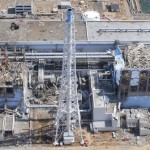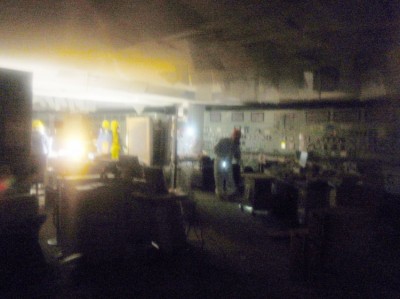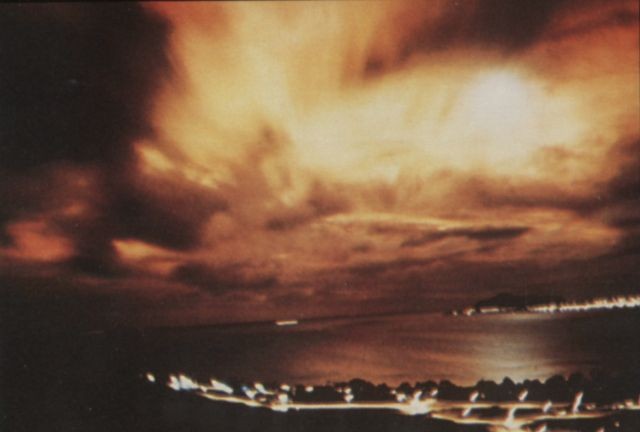Created by artist Isao Hashimoto.
Category Archives: Nuclear
Mystery Explosion Over Sverdlovsk
I am intrigued by dashcam footage showing a huge flash of light in the night sky near Ekaterinburg in Russia’s Sverdlosvk region. The video was reportedly taken on November 14 and made its way to Russian TV. Since then, others eyewitness reports have come in.
Perhaps the most likely cause would be a meteor similar to the Chelyabinsk event of February 2013. Except – this one looked very different. See for yourself:
Very strange. This reminds me of images and footage of the high-altude nuclear tests conducted by the U.S. and Soviets in the late 1950s and early 1960s.
If I counted correctly, there were 17 high altitude detonations (and 4 failures), ranging from just over 1 kiloton to 1.4 megatons, at altitudes between 23 and 540 km. The results were partially unexpected but scientifically most fascinating. Many details are kept secret until today.
The era of these tests did not last long. The Partial Test Ban Treaty of 1963 was expanded by the Outer Space Treaty of 1967, which banned the stationing and use of nuclear weapons in space. Effective today, the Comprehensive Nuclear Test Ban Treaty of 1996 prohibits signatories from detonating any kind of nuclear device – although ratification and compliance remains a problem.
Given the current political tensions between Russia, the U.S. and Europe – would any nation capable of doing so dare to violate the treaties? Without doubt, some aspects of such tests would be scientifically enticing, but there are rather unattractive radiological side effects. And, the political fallout would be as bad or worse than the radioactive kind.
At some point, Russia might begin to argue that the earlier treaties no longer apply, because they were entered into by its predecessor the Soviet Union. But at least, Russia has signed the Comprehensive Test Ban Treaty in 1996 and ratified it in 2000, whereas the U.S. only signed in 1996, but failed to ratify until today.
And then there are the technological risks. The tests 5 decades ago fried several satellites with radiation and created artificial radiation belts with astounding staying power. Electromagnetic pulses disrupted ground installations and caused quite a bit of damage. Today, we have thousands of satellites and a manned space station in orbit, so the effects of a nuclear detonation could be a lot more severe.
All this leads me to hypothesize that if the Ekaterinburg-event was indeed a secret weapons test of some sort, it would have been something entirely new and exotic, and most likely non-nuclear. On the other hand, the “meteorite” explanation does not satisfy my curiosity either.
Chernobyl And The Absurdity of Thresholds
 Today is the 25th anniversary of the beginning of the Chernobyl disaster. I was in Vienna, Austria at the time. More than 1,000 km away — but still not at a “safe” distance, as we eventually found out.
Today is the 25th anniversary of the beginning of the Chernobyl disaster. I was in Vienna, Austria at the time. More than 1,000 km away — but still not at a “safe” distance, as we eventually found out.
We did not hear about the disaster until several days later. The Scandinavians had sounded alarm bells when they suddenly observed radioactive precipitation. For several more days, the Soviet Union denied any involvement. The Kremlin then proceeded to downplay the true scale of what was going on at the plant, which was engulfed in a radioactive inferno straight from hell.
Meanwhile, things were getting scary for us. Heavy rain was falling in Vienna and many areas in Europe. The news got worse from hour to hour. Within days, the radioactive fallout could be measured in grass, vegetables and in dairy products.
Soon thereafter, radioactive pollutants from Chernobyl could be measured in many food products. In some, they exceeded legal limits. Whether these products were really discarded (and where) will forever remain a mystery. Who could tell for certain?
One particular method by which the contamination problem was handled was fascinating: suppose a dairy plant has milk with levels of cesium-137 (also spelled “caesium”) above the legal threshold. Rather than throwing out good money, it is perfectly legal to simply mix the contaminated milk with milk from an uncontaminated area. Voila! No costs for discarding the radioactive batch. And the product can still be sold legally. In other words, the mass of consumers becomes a nuclear waste disposal without even knowing it.
It turned out that concentrating certain foodstuffs also concentrates the radioactive contaminants. For example, if dry milk powder is made from milk contaminated with Cs-137, the concentrations can get quite high. Dry milk powder is the main component of baby formula. What to do with all the contaminated baby formula?
Some of the contaminated batches were reportedly sent to Third World countries. The “rationale”: slightly contaminated formula is better than no formula, and besides: since there was less “overall” exposure on other continents, the people there would still receive less than the maximum “allowable” dose.
Which brings me to an important point. Who decides what “allowable” and “acceptable” exposure thresholds are?
We could go into how the observational data was obtained, and how the “scientific consensus” was formed. But it would be long-winded and complex. Perhaps this is good subject for a book I might write one day. (It would shock most of you).
If there is truly a scientific consensus, why do the legal limits vary from country to country?
Then, there’s the problem with all thresholds. At Fukushima, there is now a forbidden zone 20 km around the reactors. Tens of thousands of people have unceremoniously been kicked out of their homes and businesses and are not allowed to return.
So if a house is 19 km from the plant, one is ordered to leave. If a house is 21 km away, it is supposedly safe and everyone should be happy? (Because some force of magic stops radioactive stops at the 20 km mark?)
Let’s say the Great Leader (based upon the esteemed opinions of highly respected experts selected by the Great Leader) sets the legal threshold of I-131 in water to a certain level. Does this mean we are perfectly safe if we drink just as much water to consume only 99% of the legal level? But if we ingest 101%, we might suddenly keel over?
Isn’t the same water used to make coffee for a 90-year old the same that’s used to make infant formula, which may be the main source of water and calories for a baby?
Is there is no difference between heavy-set grandpa who eats sushi only on occasion, and a young woman who weighs half of grandpa, is pregnant and loves seafood?
In addition to the whole demented absurdity surrounding thresholds, there is another inherent problem. Numbers tend to promote a sterile, dehumanizing viewpoint. The root data are just based on statistical evidence, but worthless when viewed from the level of an individual human being affected by real life consequences.
Let’s say contamination with a certain substance causes cancer deaths to 1/1000th of a percent in the population. You might say: Okay, that’s a very small risk, considering that 20% of the population in industrialized countries dies from cancer anyway. Therefore, 1/1000th of a percent is quite acceptable.
But 1/1000th of a percent would mean 3,000 deaths in the United States. Now picture 3,000 people. Can you look each them into the face and tell them that their death from cancer is “acceptable” to you?
What if you or one of your loved is among this group of 3,000? Ah, you see? Most likely, you would not find this to be quite acceptable. In the end, what is acceptable (or not) gets rather personal.
Today, there are still hundreds of farms in Britain on which sheep milk contains more than the “acceptable” levels of radioactive contamination. Just a few weeks ago, wild boar in Austria were found to be contaminated beyond the legal thresholds. (The investigators had bought the contaminated boar’s meat off the shelf, in regular stores). And there are similar problems with some reindeer in Scandinavia.
How many lives did the Chernobyl disaster take? Estimates range from several thousand additional cancer deaths to several hundred thousands. (A recent paper on the subject was presented by Lisbeth Gronlund here).
But just like thresholds and maximum exposure levels, these numbers are not based on real, direct hard evidence, but rather on theories, assumptions, inferred conclusions and speculation.
Unfortunately, the whole truth will never be known.
Drones Over Fukushima
 I recently wrote a feature story about the many uses of unmanned aerial vehicles (“drones”). It was published in February 2011 issue of the German Gruner+Jahr publication, Wunderwelt Wissen.
I recently wrote a feature story about the many uses of unmanned aerial vehicles (“drones”). It was published in February 2011 issue of the German Gruner+Jahr publication, Wunderwelt Wissen.
I truly believe that drones will revolutionize law enforcement, border patrol, search and rescue, security, agriculture, environmental monitoring, fire fighting, traffic control and many other areas.
Here is a good example for what drones can do. Flying over the Fukushima reactors is very dangerous at this time. Not only because of the direct radiation, but also because radioactive particles can get sucked into aircraft. Unmanned drones, on the other hand, can fly very close and and provide images and measurements around the clock. Some can even hover in the air and get within a few meters of parts to be inspected.
Here are a few aerial shots.
Neutron Beam Indicates Coverup at Fukushima
Although I have been covering the nuclear industry, nuclear weapons and proliferation issues for about 20 years, I have not commented on Fukushima on this blog. I didn’t feel I had anything to add to what was being reported in the popular media.
But now, the information being released is beginning to appear inconsistent and contradictory. These are signs of a coverup in progress.
The nuclear event at Fukushima looked bad from its very beginning with the Tohoku 2011 earthquake. My initial concern was that it could get much worse from there. And it did.
I think my Australian colleague Mark Colvin summed it up best in his Twitter message: “Most worrying thing about Fukushima: every day something happens that was categorically ruled out the day before.”

A ghostly image from inside the control room at Fukushima, where emergency workers are trying to assess the situation with flashlights. Click to enlarge. Foto: TEPCO
It is rather typical for such incidents that the public is not told the entire truth at all times.
I remember Chernobyl well. I was in Vienna at the time, when suddenly the Scandinavians began to wonder why they were suddenly measuring radioactivity in remote lakes, and soon thereafter, in the rain. The Soviet Union was still not admitting that their Chernobyl reactor No. 4 was literally on fire and out of control.
The Chernobyl event turned out to be the most massive nuclear debacle in history, forcing the evacuation and resettlement of hundreds of thousands of people, spewing radioactive pollution over areas thousands of miles away, and resulting in countless deaths. And yet, the seriousness was only gradually admitted — too late for many who ultimately paid with their lives.
Let’s jump back to Fukushima: there was a little noticed tidbit released by Japan’s Kyodo news agency. It reported that a neutron beam had been detected on 13 different occasions, over a period of several days, at a location 1.5 km (about a mile) southwest of the plant. (Source: http://english.kyodonews.jp/news/2011/03/80539.html)
The beam was reportedly weak — but this distracts from the real issues: Why was it there in the first place? And why was it not made public until 10 days later?
When heavy atoms split in an event called “nuclear fission”, highly energetic particles called “neutrons” shoot out with high velocity. They are so fast that they will simply fly through most matter.
Although these free neutrons can damage living tissues through which they pass, they are too fast to split heavy atoms. Therefore, in a nuclear reactor, a “moderator” substance is employed to slow them down. At just the right speed (and therefore: the right energy level), these neutrons will split additional heavy atoms in the nuclear fuel. This results in the release of more neutrons, which split more fuel atoms, and so forth — the so-called self-sustaining “chain reaction”.
Normally, these free neutrons are contained within the reactor vessel. They certainly should not be measurable from a mile away. For the neutron beam to exist, some kind of nuclear fission reaction must have taken place without shielding. But how and why?
So the report of a neutron beam is very alarming for several reasons:
First, it could be an indication that a reactor containment vessel has split open. Or, at least that pipes have vented or spilled gas or liquid containing fissile materials from the inside of the reactor core.
Unfortunately, it is most likely that the point of origin would have been Fukushima Daiichi Unit 3. This is the only of the three destroyed units running on mixed-oxide fuel. This type of fuel contains a high percentage of plutonium, which could be the explanation for the observed neutron beam.
Depending on how bad the leak is or was, this might mean that the surrounding ecosystem could be poisoned for generations.
But what alarms me even more is that the neutron emissions were reportedly detected on March 13, but not admitted to the public until March 23. What exactly happened on March 13?
In hindsight, it now seems interesting that days ago, some sources at the IAEA were already speaking of suspicions that the primary reactor containment vessel had failed. But they did not clarify what evidence they had.
Has the IAEA been told of the neutron emissions much earlier, and has everyone conspired to keep this tell-tale sign from the public? Perhaps in order to allow an ordered evacuation?
During the subsequent days and until today, the official line of TEPCO has been that a primary vessel breach was “unlikely”, then “not certain”. Today, Japan’s prime minister reportedly voiced concerns that indeed, it may have occurred.
Short of a reactor containment vessel breach — could the neutrons have originated from spent fuel? Not unless there is something very seriously wrong. After fuel elements are used in the reactor, they are hot and highly radioactive. So they are stored outside of the primary reactor vessel, in a “spent fuel pool” of water. The water does two things: it cools the fuel, and it also absorbs some of the radiation it emits.
The fuel for the types of reactors used at Fukushima Daiichi comes in form of pellets, which are contained in long metal rods. We know that at Fukushima some (most? all?) of the water in the pool was lost. The fuel elements were partially or fully exposed to air. Without proper cooling, the casings holding the fuel may split, and gases containing fissile materials may escape.
Meanwhile, workers have been dousing the reactors inside the destroyed buildings, and the exposed spent fuel elements with salty sea water, which of course is corrosive and generally a material of last resort among firefighters.
Minerals from the water will undergo chemical reactions with the radioactive isotopes emitted from the reactors or leaking spent fuel elements. This results in thousands of different radioactive chemicals with different soluability, some of which will seep into the soil, ground water and the coastal waters. But right now, this is seen as the lesser evil.
Still, the flow of information is spotty and consists of pieces of a puzzle that does not seem to fit together. Something is very fishy here.
UPDATE, March 26, 2011:
TEPCO admitted today that water pools in the basement of at least one reactor building was “10 million times more radioactive” than what was to be expected of water from inside the reactor cores. This is another indication that (a) casings of fuel elements have broken and (b) a primary reactor vessel has been breached.
UPDATE, March 27, 2011:
In a stunning reversal comes now TEPCO’s announcement that it made a “mistake in the assessment of the measurement of iodine-134” and that the “the number is not credible”.
As Julie Makinen and Kenji Hall write in the Los Angeles Times today, “But now, more than two weeks into the disaster, the updates — via news conferences, press releases, website data charts and Twitter feeds, all laden with technical terms such as “bequerels,” “microsieverts,” “millisieverts” and “iodine-131″ — have become so frequent and so granular as to become essentially indecipherable and meaningless to the average person.”
Actually, I’d expand this to say the releases (both the radioactive and the information) are full of gaps, contradictory and inexplicable even to experts.
UPDATE, March 28, 2011:
According to TEPCO announcements today, traces of plutonium have been found in several soil samples taken from the site. This is almost irrefutable proof for a breach for a primary reactor containment vessel, fuel element casings, and a partial fuel meltdown.

